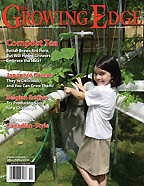"I think I'll go out and water the tomatoes" I said to Jessica thinking that I had not watered the tomatoes growing on the deck and on the side of the house. It had been at least a week since I'd even thought about the tomatoes languishing and dying in the neglected wick systems in the back yard. "Aren't you going to pick those red tomatoes?" Jessica asks, and "It's raining and they're being flooded back there."
I wasn't even sure what she was talking about since I had abandoned the wick system in my mind since the other two systems were doing so much better. There were tons of tomatoes in the three pots on the deck and quite a few, though smaller for the most part (cultivars) on the four tomato plants by the side of the yard. But I said, "Sure I'll go out and look and bring back any red ones."
In the back yard the wick system looked run down and the plants mostly dead or dying straggly, but the tomatoes on them had ripened and I picked ten and brought them in. They were mostly small donas which are a tomato I really like although Jessica thinks they are way too small. But they are very round, very red, and very tasty. I put the ten on my digital kitchen scale where I weigh all my tomatoes. They weighed in at 1# 1oz — 17 ounces total.
I took out my pocket notebook and made a note. That brought the total of the Late Start Systems to 114 tomatoes with a weight of 204.125 ounces, an average of less that two ounces each although there were some tomatoes that had come in at around 13 ounces it wasn't very many. And this is the total as of September 27th — It won't be too long now before the cold weather sets in. So starting late has been not too smart. I have to get a picture of the many many tomatoes on the plants in the deck pots. They are the most luxurious growth this year.
Live and learn really. You get out of things what you put into them. My motivation for the wick systems was to try for a system I didn't have to maintain too much. It worked for a while, but I think the lack of oxygenation probably was a mistake. Still I didn't want to aerate the water or use electrical devices.
I saw a system that was being used in Africa to help people grow hydroponically and they did their aeration by physical shaking the float system making the water splash. They did that for hours a day. That's hard. I suppose I shouldn't complain about what happened when I chose to do nothing. I didn't run out my aquarium air pump and pump tiny bubbles into the water. I just let things sit. I'll have to think of some other recipe for the passive system. Wick systems without oxygenation seem to be a bit of a dead end. Of course it could have been something else. The plants did end up with some plant diseases so I suppose I should do some research in that direction too.
For all the soul searching, the kitchen counter is full of tomatoes. Jessica and I don't need nearly as many tomatoes as we get, although this year with the late start we've not been getting anything like past seasons. Later on I'll put up a contrast between this year and years past with earlier starts.
 I've been wondering what a float system with a fountain sort of thing in the center might do. They have these little plastic baby pools for kids that might do for a float system, not the blow up kind, the hard sided kind. It might be possible to either make a little central waterfall or a fountain that doesn't go too high, you don't want wind to blow the stream so it doesn't land in the pool.
I've been wondering what a float system with a fountain sort of thing in the center might do. They have these little plastic baby pools for kids that might do for a float system, not the blow up kind, the hard sided kind. It might be possible to either make a little central waterfall or a fountain that doesn't go too high, you don't want wind to blow the stream so it doesn't land in the pool.













